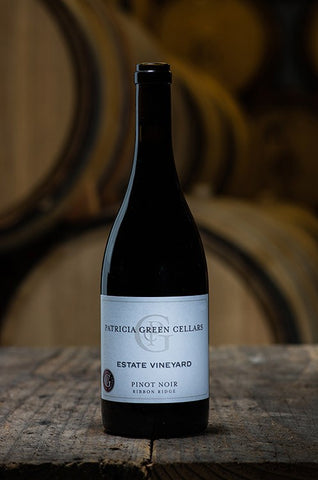Wine Making and Notes:This bottling has always been a powerful view of this vineyard site and we still have blocks in the vineyard in the 10-21 year-old range that have not made (will not make?) the change to the far more chic and mineral-driven Estate Old Vine style. That is fine. Our Estate Vineyard is fairly large and incredibly diverse, so having two very different wines coming off of it is great. To us, this is the exciting part of Pinot Noir and vineyard management, and the marriage of the two in winemaking.
The wine is dark in color, dense in earth-tinged dark fruits with relatively thick tannins. However, as the vineyard has aged, fewer blocks are still producing this style of wine that seems to be indicative of the young vines. This comes from just three blocks: a 1998 southeast-facing planting of Pommard, a 2000 south-southeast facing planting of Pommard at lower elevation and, for the first time ever, a 2000 planting of Pommard that faces east at the top and back of the vineyard. This section has finally developed into something beautiful and representative of this site and particular bottling and we are very excited about its inclusion in this wine! The lower block of Pommard by the winery was done with 50% stem inclusion while all the fruit from the other two blocks were done as 100% de-stemmed. Everything went through a standard cold soak of about 4-7 days depending on the block, fermented in 1.75-ton open-top fermenters and was pigeaged 1x/day before being pressed and allowed to settle for 3 days. This spent a little less than a year in barrel with only 3% being new barrels while 86% were neutral so there is minimal oak influence in this wine allowing the pure nature of this dark Ribbon Ridge bottling to really come out. We dry farm our vineyard and these younger vines, even at 19-21 years of vine age, are still under a bit of duress. This leads to small, tight clusters and fairly thick skins. This gives the wine its trademark dark, almost purplish color with a hefty and dense structure. This can be a bit savage in nature when youthful but it comes around surprisingly fast and, of course, is good for many years.
Location: Ribbon Ridge is a sub-appellation of the Willamette Valley AVA that sits 22 miles southwest of Portland, 4 miles northwest of Dundee and 40 miles east of the Pacific Ocean. Ribbon Ridge is contained within the larger Chehalem Mountains AVA - which is contained with the Willamette Valley AVA.
Wine history:In 1980, Harry Peterson-Nedry planted the first wine grapes on Ribbon Ridge at his Ridgecrest Vineyards. Two years later, the first commercial vineyard was established with the planting of 54 acres of Pinot noir and Chardonnay. It was Yamhill Valley Vineyards who first used these grapes to make wine in 1985. Other vineyards were soon planted in this relatively small ridge. The appellation became official in 2005.
Climate: Protected by geographical features to the north, south and west, Ribbon Ridge's grape-growing hillsides are slightly warmer and drier when compared to the adjacent valley floors. Ribbon Ridge's moderate climate is well suited for early grape growth in the spring, consistent and even ripening over the summer and a long, full maturing season in the fall.
Soils: The Ribbon Ridge region contains primarily sedimentary soils that are younger, finer and more uniform than the alluvial sedimentary and volcanic soils of neighboring regions. These moderately deep, well-drained silty-clay loam soils are part of the Willakenzie soil series and are of low fertility and ideal for growing high-quality wine grapes.
Topography: Geographically, Ribbon Ridge is a 3.5-mile long by 1.75-mile wide ridge that extends from the Chehalem Mountains. The ridge rises 683 feet from the Chehalem Valley floor, giving it an island-like appearance.
Site Characteristics:The two sets of plantings (1990-1994 and 1997-2001) continue to show enormous distinctions between one another giving us these two unique bottlings. The Estate bottling consists of 11 separate sections of the vineyard that were planted in the 1997-2001 window. For this bottling we have many sections of the vineyard to choose from and clones ranging from Pommard, Wadensvil, Dijon 114 and Dijon 777. Over the years the base of this wine has been the Pommard and it’s powerful, rich and oft times gamey signature. However, the block with the most potential has always been the 1997 planting of Wadensvil. While it has taken fifteen years for that block to begin realizing its enormous potential the first sign of it is in this bottling. Nearly 40% of the wine is from Wadensvil Clone while the rest is made up of nearly equal parts Pommard and Dijon 114. While this shift does not inexorably change the bottling there is a bending toward some more red-toned fruit even while this wine remains darker, earthier and more structured than most of our other wines.

